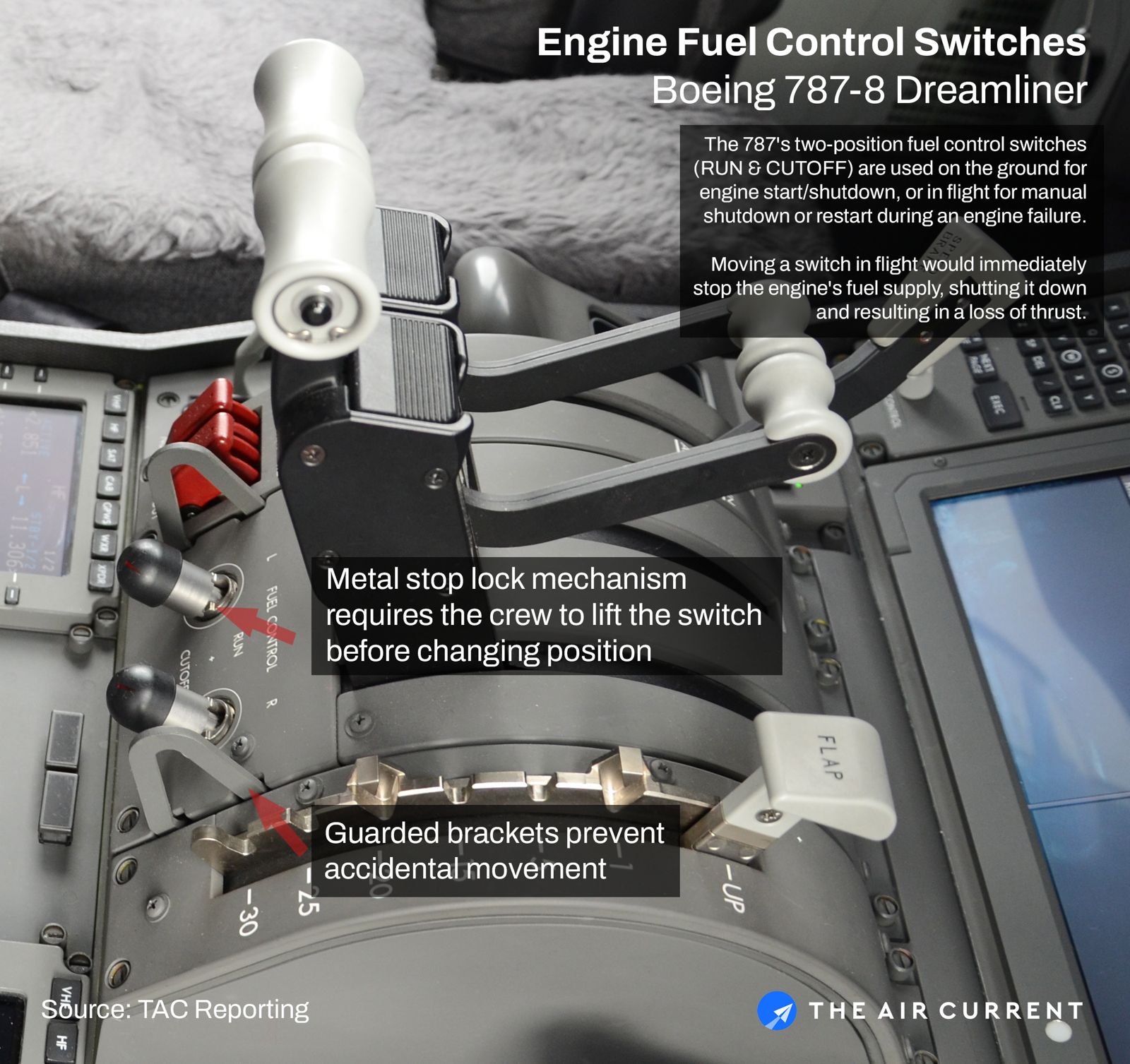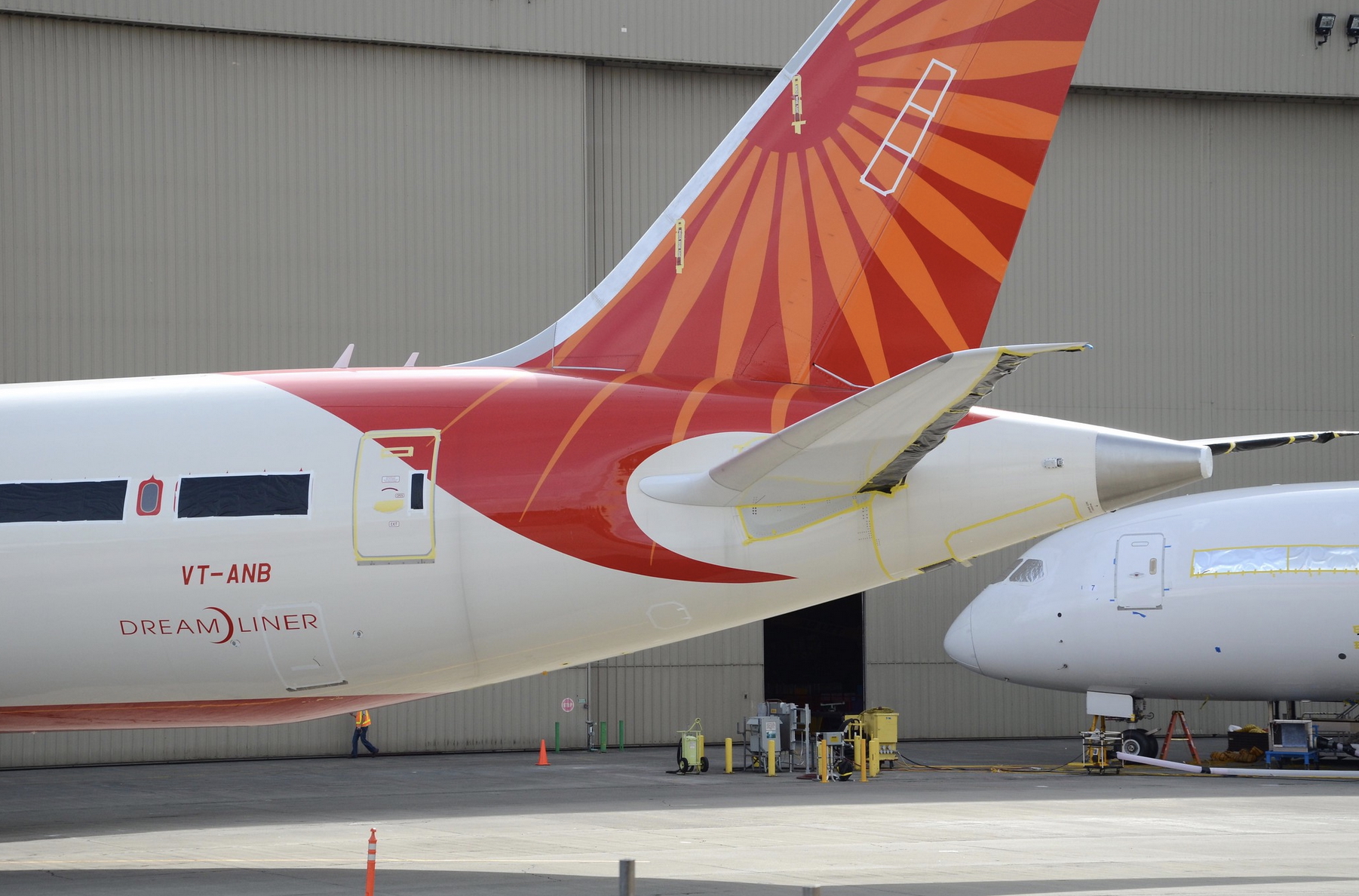Log-in here if you’re already a subscriber
Air safety reporting by The Air Current is provided without a subscription as a public service. Please subscribe to gain full access to all our scoops, in-depth reporting and analyses.

The ongoing investigation into the cause of the June 12 crash of Air India flight 171 has narrowed its focus to the movement of the engine fuel control switches, following an analysis of the Boeing 787’s integrated flight and voice data recorders, multiple people with knowledge of the investigation tell The Air Current.
The crash killed 241 of the 242 passengers and crew aboard the aircraft and 19 people on the ground 32 seconds after it took off from Ahmedabad airport in India bound for London’s Gatwick Airport. A preliminary report from India’s Aircraft Accident Investigation Bureau (AAIB) is expected to be released around July 11 in New Delhi, marking 30 days since the first fatal accident involving Boeing’s latest-generation widebody.
Under International Civil Aviation Organization (ICAO) rules, “states in charge of an investigation must submit a Preliminary Report to ICAO within thirty days of the date of the accident.”
Just how much information will be included in the report remains to be seen. ICAO notes that “Preliminary Reports may be marked as confidential or remain public at the investigating State’s discretion,” according to frequently asked questions listed on the United Nations body’s website.
Related: AI slop fills the information void of Air India crash investigation
At this point in the inquiry, the data available to the investigators does not indicate a mechanical or design issue with the 787 or its two GE Aerospace GEnx-1B engines, TAC is told. The knowledgeable people who spoke with TAC also indicated that post-accident analysis showed no sign of fuel contamination or improper retraction of the aircraft’s flaps, two factors often speculated as possible contributors to the accident.
The familiar people said the lack of any kind of advisory warning from Boeing or GE to operators, known as a multi-operator message (MOM) or all-ops wire, in the 13 days that have followed the initial black box reading in Delhi by the AAIB on June 25 is a key signal that a mechanical failure is not immediately suspected as the likely cause of the crash. No urgent recommendations have been issued by the AAIB or the U.S. National Transportation Safety Board, nor a Continued Airworthiness Notification to the International Community (CANIC) from the U.S. Federal Aviation Administration.
An initial call for inspections of Air India’s 787 fleet by India’s Directorate General of Civil Aviation (DGCA) immediately after the accident did not yield any clues to the investigation.
The AAIB did not immediately respond to a request for comment. The NTSB and Boeing referred all inquiries to Indian authorities. A GE Aerospace spokesman declined to comment citing the active investigation. The FAA referred all questions to the NTSB.

All of the people who spoke to TAC said that details surrounding movement of the engine fuel control switches will take months — if not longer — to analyze alongside other available data and findings. The focus of investigators could change during that time, they said. Typically, a preliminary report does not include any analysis and is only written to establish the facts of the investigation known at that time.
The crash, which is the first fatal accident involving Boeing’s flagship 787 Dreamliner, has attracted intense global interest. India’s Ministry of Civil Aviation and AAIB have received criticism for its inconsistent communication, slow pace and lack of disclosures of verified facts since the crash, creating an information vacuum filled with intense speculation and outright misinformation — much of it originating from generative AI platforms.
According to the people familiar, the available information on the black boxes at this point cannot rule in or out improper, inadvertent or intentional actions that preceded or followed the apparent loss of thrust before the aircraft crashed into a hostel for students at BJ Medical College.
It is not known to TAC whether one or both of the fuel control switches for the GE engines in the cockpit were moved in the moments after takeoff from Runway 23 in Ahmedabad.
Related: Air India 787-8 Ahmedabad crash first fatal accident for Dreamliner
A 787’s flight data recorder would capture the position of those switches, the precise timing of any movement and the sequence in which they were moved, along with a myriad of engine performance data to evaluate the health of the aircraft and its engines. The 787’s two integrated voice and data recorders capture 25 hours of data.
Those fuel control switches have two positions, RUN and CUTOFF, and are only moved on the ground during engine start and shutdown at the end of a normal flight — or if an engine needs to be manually shut down or restarted by the crew in the event of an engine failure in any phase of flight.
Moving a fuel control switch from RUN to CUTOFF in flight would cause the fuel supply to stop flowing to the associated engine, resulting in its immediate shutdown and the loss of any thrust. That would also stop the two electrical generators on each engine from providing power to many of the aircraft’s systems and some of its cockpit displays.
The fuel control module underneath the jet’s throttle handles holds the two switches, which are guarded with brackets on either side to prevent accidental movement. A metal stop lock mechanism on each switch is designed to require the flight crew to lift each switch past the stop in order to move it.
In the event of an engine fire, the fuel control switch for the affected engine would illuminate in red, providing a key visual cue to the crew.
 The accident airplane, VT-ANB, seen here in 2011 waiting for change incorporation at Boeing’s Everett, Washington widebody plant ahead of its 2014 entry into service with Air India. Early production 787s underwent extensive changes following the jet’s protracted development.
The accident airplane, VT-ANB, seen here in 2011 waiting for change incorporation at Boeing’s Everett, Washington widebody plant ahead of its 2014 entry into service with Air India. Early production 787s underwent extensive changes following the jet’s protracted development.The 787’s advanced fly-by-wire flight control system automatically compensates for any difference in thrust coming from one of the engines. Unlike the earlier-generation 777, the 787’s flaperons, ailerons and rudder would automatically and fully adjust to keep the aircraft flying straight and not yawing toward from the ailing engine. The pilots also receive a tactile cue to asymmetric thrust with the automatic movement of the rudder pedals.
The Wall Street Journal on June 18 reported that investigators believed Flight 171’s emergency power system had been active at the time of the crash, with the jet’s backup ram air turbine (RAT) deployed to provide a limited amount of electrical power to the aircraft that includes its main flight control surfaces and two spoiler panels on each wing.
Not powered by the RAT is the aircraft’s landing gear, which would remain immobile until the engine-driven hydraulic pumps were restored or the auxiliary power unit (APU) activated.
The APU activates automatically in the air in the event three of the four engine generators that supply electricity to the aircraft are offline, as would be the case in a dual engine shutdown. Boeing estimates the APU takes roughly 90 seconds to start under standard conditions, according to a technical description of the auxiliary power system reviewed by TAC.
Write to Jon Ostrower at [email protected]
Subscribe to Continue Reading
Our award-winning aerospace reporting combines the highest standards of journalism with the level of technical detail and rigor expected by a sophisticated industry audience.
- Exclusive reporting and analysis on the strategy and technology of flying
- Full access to our archive of industry intelligence
- We respect your time; everything we publish earns your attention
.png)



